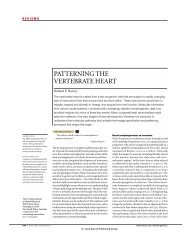PDF1 - University of Maryland School of Law
PDF1 - University of Maryland School of Law
PDF1 - University of Maryland School of Law
You also want an ePaper? Increase the reach of your titles
YUMPU automatically turns print PDFs into web optimized ePapers that Google loves.
ai gains skills and income but remains alwaysavailable both to the individual with a disability andto the employer. 47Kathy Moore, executive director <strong>of</strong> New EnglandBusiness Associates, provided the Commission withthese examples <strong>of</strong> people active in the program:J. C. pr<strong>of</strong>oundly deaf, legally blind, severely retarded1987-88 earnings $7,860.00M. D. pr<strong>of</strong>oundly deaf, legally blind, brain tumor,mentally retarded, institutionalized at birth 1987-88 earnings$6,220.85M. Gl. pr<strong>of</strong>oundly deaf, totally blind, pr<strong>of</strong>oundly retarded,institutionalized at birth 1987-88 earnings $7,221.60M. K. pr<strong>of</strong>oundly deaf, totally blind, severely mentallyretarded 1987-88 earnings $2,163.00E. R. pr<strong>of</strong>oundly deaf, totally blind, severely retarded,progressive sensory neural loss 1987-88 earnings$10,400.00L. T. pr<strong>of</strong>oundly deaf, totally blind, severely retarded,institutionalized at birth 1987-88 earnings $332.13"A similar program for adults with autism andsevere behavioral difficulties has been operating inMontgomery County, <strong>Maryland</strong>, for almost 8 years.This program, run by Community Services forAutistic Adults and Children, included over 46persons ruled "unemployable" by every agency theyhad ever contacted. After living most <strong>of</strong> their livesin institutions, now all live in small homes inRockville, <strong>Maryland</strong>, and all earn at least theminimum wage in a program using supported employment.49An 8-year longitudinal study <strong>of</strong> the costs andbenefits <strong>of</strong> supported employment for 117 personswith moderate to severe mental retardation foundthat, in comparison to the $1,361,951 that wouldhave been required in SSI payments and alternativeservice programs had these persons not been employed,the supported employment program cost$1,212,117. Those participating in the program47Interviews with Kathy Moore, Executive Director, NewEngland Business Associates (Sept. 19-20, 1988).48Id.49Interview with Susan Goodman, Executive Director, CommunityServices for Autistic Children and Adults (Sept. 17, 1988).earned wages totaling $l,503,779. 50 In other words,in place <strong>of</strong> a net average cost <strong>of</strong> $11,640.61 for eachperson with moderate or severe mental retardation,with supported employment there was a net averagebenefit <strong>of</strong> $2,492.84 for each such person. Theauthors <strong>of</strong> the study pointed out that with ongoingjob retention, the net benefit will significantlyincrease over time, since the costs <strong>of</strong> supportiveemployment are substantially frontloaded while theaverage income is constant or increasing. 51 Furthermore,they noted:Our university-based demonstration is very small; in fact,the. . .consumers served over 8 years are unfortunatelydwarfed when compared with large day programs inwhich the sole purpose is to provide vocational or daycare services. Consider the dramatic savings in programs,over time, if substantial reorganization <strong>of</strong> the operations atthe centers were converted to community- or industrybasedprograms. It is in this area where the truly largedollar savings can be made over a multi-year time period. 82ConclusionDisability does entail cost. But the real economiccosts now associated with disability are less afunction <strong>of</strong> the disability or its severity than <strong>of</strong> apolicy that tends to segregate and isolate, at enormouspublic cost, those persons considered mostseverely disabled. The assumption has been that thelevel <strong>of</strong> severity <strong>of</strong> disability is the major determinant<strong>of</strong> lifetime costs and, consequently, that themore severely disabled a child may appear to be atbirth, the less likely it is that the child will be able tocontribute as an adult to his or her own economicsufficiency and the more expensive it will be to meetthat person's basic needs. Although this assumptionis unfounded, it has resulted in a self-fulfillingprophecy: a diagnosis <strong>of</strong> severe disability leads toplacement <strong>of</strong> a person in an institutional and nonworkenvironment that significantly limits thatperson's capability and entails far more expense thannecessary.50Hill, Wehman, Kregel, Banks & Metzler, Employment Outcomesfor People with Moderate and Severe Disabilities: An Eight-Year Longitudinal Analysis <strong>of</strong> Supported Competitive Employment,12 J. Ass'n for Persons with Severe Handicaps 182, 185-86 (1987).51Id. at 187-88.53Id. at 188 (emphasis in original).55
















